If you’ve ever brought home a venus fly trap from the grocery store, you’re likely already aware of how neat these little plants can be. Plants that consume insects and other living things are called carnivorous plants, which is a Latin-derived term for “meat-eating” plants.
Such a unique evolutionary niche isn’t so recent in the timeline of plants on Earth, though. These things have been munching on unsuspecting victims since there were dinosaurs alive to munch on the plants themselves.
There are a few evolutionary theories out there that attempt to describe the evolutionary path for these interesting meat-eating plants, but alas, no definitive proof of any theory exists that we yet know of. That’s ok, for most of us.
There are tons of types of carnivorous plants well beyond your average venus flytrap, with new discoveries about species and their behavior coming to light all the time. It’s possible that there are lots more species out there yet to be discovered.
That’s part of what makes carnivorous plants such exotic and thought-provoking houseplants. Most of them can survive with a little bit of extra care and accommodation in our homes, as many of them are tropical plants accustomed to similar temperatures as ourselves.
A Brief History of Carnivorous Plants
Back in a time when evolutionary theory was in its infancy, folks downright refused to believe that a plant could lure, capture, and consume a living organism. In some places the idea was considered blasphemous; in others, they became a tale.
Just as Darwinism finally peaked, stories were spun about the giant, man-eating plants that could swallow up a grown man or eat an elephant in just a few bites. Some of the greatest horror tales in ancient history revolved around, or at least contained, examples of plants eating people and other animals.
As the superstitious hype died down over decades and centuries, the scientific hype ramped up to replace it. Botanists, horticulturists, and really anyone who could stretch a title to work with these meat-eating plants researched them to every possible degree as technology advanced.
Today, carnivorous plants are spread around the world as collectibles, sold and marketed as pest-control solutions, pet plants, and even (still) murder plants. The research has never faltered; we now understand much of the mechanics of these plants.
Something unique and haunting about carnivorous plants is what forced the hand of mankind to collect, mass produce, catalog, experiment on, and distribute the cute little venus flytrap that has made its way to your kitchen windowsill. But that’s just the tip of the proverbial iceberg.
Carnivorous Plant Species
We’ll break these most bespoke and home-growable carnivorous plants down into categories to make it easier to decipher what’s what. Take a look at each category for a brief description of each subspecies, their care preferences, and how to spot them.
Identifying carnivorous plants can be tricky; modern breeders have hybridized many of the most intricate and beautiful carnivorous plants out there, which can sometimes cloud the waters. Don’t worry; most of them are from cultivars that are well-documented online!
Here are the 15 types of carnivorous plants that we will be covering in this article:
- Venus Flytrap
- B52
- Fused Tooth
- Alien
- Pitcher Plant
- Purple Pitcher Plant
- Snow Leopard
- California Pitcher Plant
- Monkey Cup
- Alata
- Attenborough’s Pitcher Plant
- Gaya
- Sundew
- Big Pink
- Round-Leaved Sundew
- Cape Sundew
- Butterwort
- Red Leaf
- Colimensis
- Gigantea
Venus Flytrap
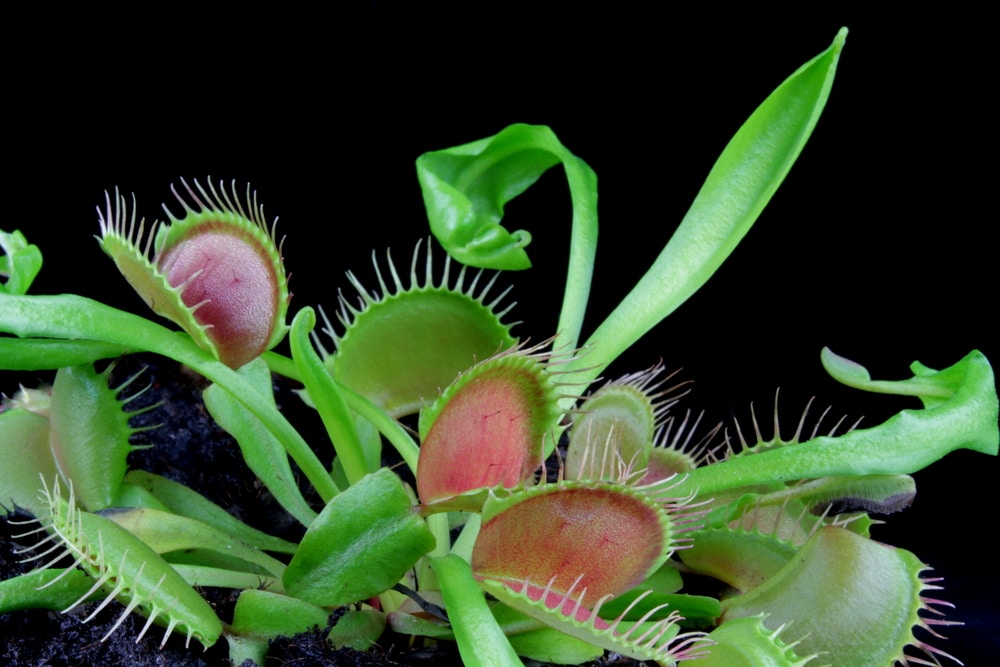
Now, technically, venus flytraps are a member of numerous subspecies. However, we thought they’d need their own mention here, especially as the one carnivorous plant species that some folks can name.
There’s a reason that there’s so much hype around venus flytraps, though. As soon as an insect flies into one of the traps located at the end of each petiole and triggers a tiny hair inside exactly three times, the trap snaps shut and imprisons the insect.
This process happens quickly; in fact, some individuals can snap shut so fast that it’s difficult to catch it happening with the bare eye. Fortunately, there are tons of videos online showing this in slow-motion.
The other fun thing about venus flytraps is that they’re among the easiest of carnivorous plants to keep, despite their somewhat bad reputation for dying a few days into coming home with you. We’ll dispel that mystery later on, but for now, check out some of the coolest venus flytraps.
B52
An odd and rather blunt name; however, there’s a lot more to this venus flytrap than the three characters that make up its legacy. This particular cultivar is perhaps the most highly sought-after flytrap, hardly ever in stock in online stores.
B52 is so incredibly popular because of its absolutely massive traps. These can grow anywhere from an inch to an inch and a half in length, with a few lucky growers seeing traps as big as two inches from time to time on particularly healthy specimens.
These traps are a vivid solid red color with bright green petioles to hold them up. B52 flytraps are constantly nabbing larger insects, such as flies, crickets, bees, and moths. They have a dormancy period in winter months, when no active growth takes place.
Fused Tooth
Another incredibly unique venus flytrap is the fused tooth hybrid, which is best known for its genetic mutation that presents only in late summer. This plant begins the season with normally formed traps, but as the season progresses, their appearance alters significantly.
The more the summer growing season progresses, the more fused the trap’s teeth become. Eventually, they start to look quite a bit like bear traps rather than insect traps. At some point, the traps do become unusable; since they can’t close properly, digestive juices aren’t effective.
However, during the rest of the year, the fused-tooth venus flytrap is quite a shower. It has the potential to grow into quite a large plant compared to other species, and reproduces like crazy if left undisturbed for long enough!
Alien
This flytrap was aptly named for its very peculiar growth patterns. The traps of this plant are incredibly elongated, which is unique to this cultivar. These traps, paired with a nice, bright tree green from petioles to roots make for a fun and interesting option.
The great thing about this venus flytrap is that it’s fairly hard to kill, if you’ve ever been able to keep a carnivorous plant alive for long. It can handle a little more temperature swings from time to time, and doesn’t brown at the very thought of a chilly breeze from a vent.
While it’s easy to please, some alien venus flytrap specimens will need to be manually fed due to their especially long traps, which don’t close very well on their own. It’s easy to do, so long as you can remember to do it often enough.
Pitcher plant
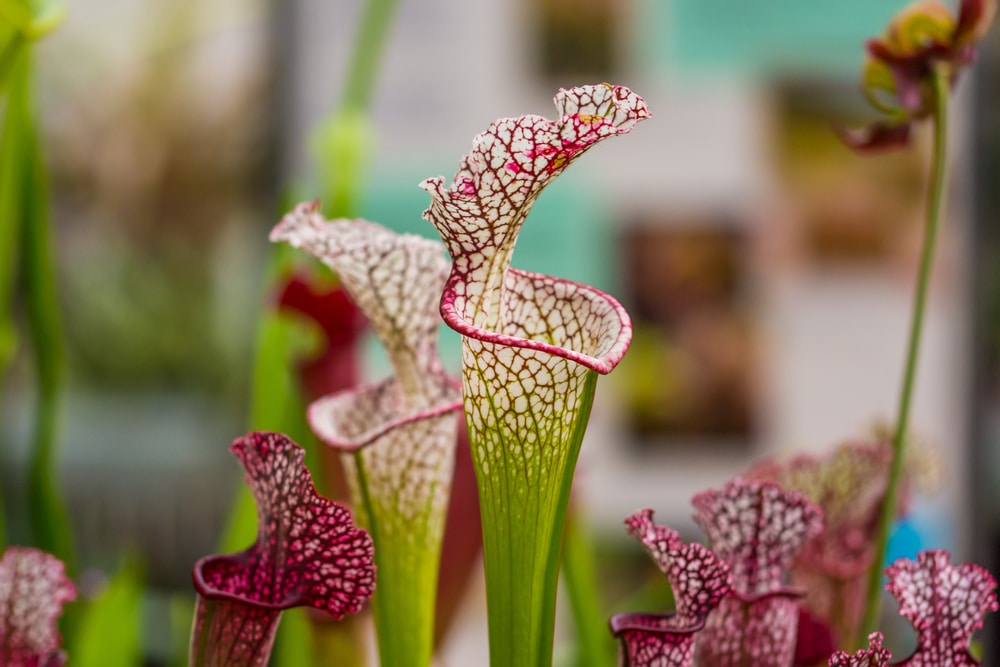
The stuff of Hollywood movies and fiction novels, these plants stick out like a sore thumb in nature. Their long, vertical tubes grow up with a lip at the top in order to attract certain types of insects, who will then fall inside.
From this point, the insects fall into a digestive liquid made up of plant enzymes that help to break down the bug into a liquid for digestion. Then, pitcher plants absorb the nutrients from the bug and the plant puts new enzymes in the trap to catch more food!
Although there are lots of different types of pitcher plants that look totally different from one another, these plants are all very closely related. Their care is relatively similar thanks to this little trait. Here are a few of the best pitcher plants to grow at home.
Purple Pitcher Plant
Sarracenia purpurea is among the most popular pitcher plants sold in the U.S., and there’s a good reason for that. Not only are these plants absolutely gorgeous, but they’re also extremely easy to care for, even as a first-time carnivorous plant.
The purple coloring of each trap comes in as they mature. Traps first appear as a light green shoot, then slowly progress to grow red veins and eventually turn the dark reddish-purple hue that everyone is nuts about.
Purple pitcher plant is also a shorter variety, which makes it a better choice for tabletops and near windows. They need lots of light to maintain their darker hues, so be sure to give them enough light to sustain their dark coloration.
Snow Leopard
As beautiful as this cultivar is, it’s a wonder that this pitcher plant doesn’t get more attention. The snow leopard pitcher plant is an absolute stunner in the carnivorous plant world as far as color and patterning, and we can’t get over it.
The long, tall and slender pitchers of this plant are usually anywhere from a darker to lighter green at the base, but this color slowly fades into a bright, blinding white color that’s contrasted with deep red veins throughout.
While most pitcher plants require very bright light (some even prefer direct sunlight), the lighter coloration on this one means that it needs a little less in the sunlight department. The light pigmentation makes for an easy sunburn, so watch for brown spots.
California Pitcher Plant
Commonly referred to as the cobra plant, this cultivar really does resemble a cobra’s head in a striking position. The top of the pitchers on these guys actually fold over top and then under, which makes for unending amazing photos.
The California pitcher plant is a great conversation starter. It looks like something that would grow in the most remote regions of the world’s tropical rainforests, and that’s because it is. While this one requires some differences in light and temperature, it’s still easy to grow.
The pitchers on these plants can grow over a foot tall, but they prefer to live outside in tropical and subtropical climates rather than indoors. High humidity is a must for this plant, and providing moisture along with the right temperature is important for proper pitcher development.
Monkey cup
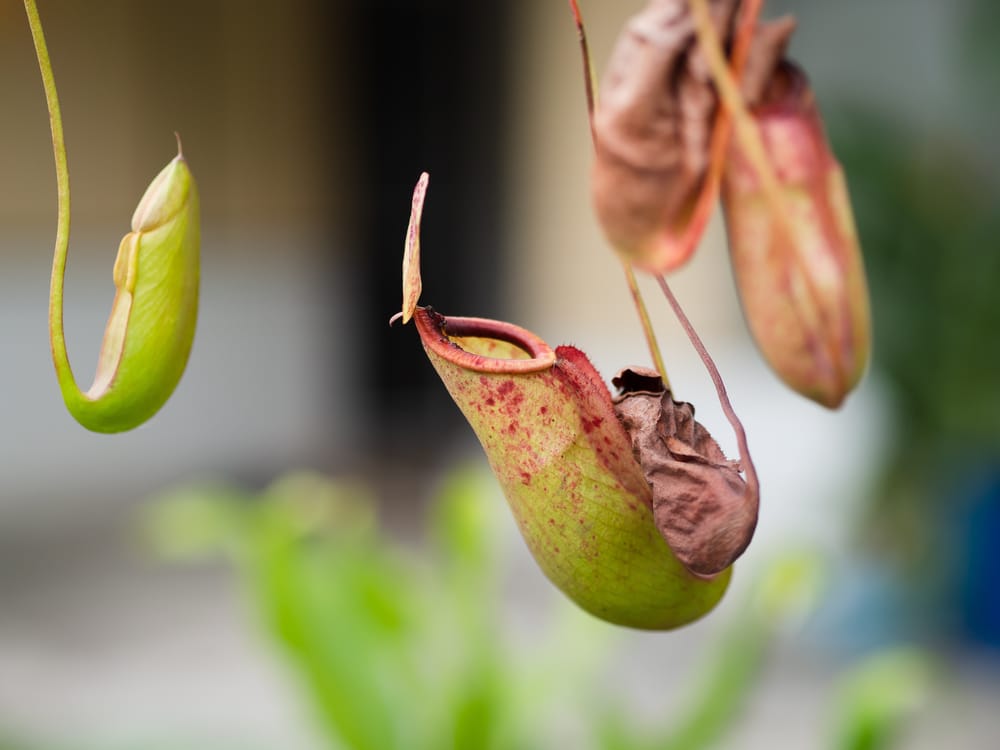
For more serious carnivorous plant collectors, monkey cups are an awesome and visually stunning group of pitcher plants that absolutely takes the cake for interest. This is an extremely popular subspecies that is used for all sorts of design references.
This plant can be spotted in some video games and animated movies, but you’ll hardly ever find someone growing it at home. Monkey cups can be a tricky plant to grow indoors, specifically due to the humidity and temperature requirements it has.
Although this plant can be difficult to grow, a greenhouse or wardian case may make it easier to handle. Consider planting monkey cups alone or with other carnivorous plants in a terrarium with holes for insects to naturally move through. Here are a few of the greats in the monkey cup kingdom.
Alata
The most basic of monkey cups, alata is a great place to start if you’ve never had the pleasure of trying to grow a pitcher plant in this category. They’re relatively easy-going, prefer to be left alone in one place, and like lots and lots of humidity.
The pitchers on Nepenthes alata are fairly similar to those of other monkey cups. They dangle from a petiole that extends from the tip of each leaf, but rather than dangle from the top of the pitcher, the petiole is attached to the bottom.
The same general form is true of this plant’s cousins, as well. The pitchers are able to hold themselves upright, and can move their lids to close or open depending on whether or not there is prey inside the pitchers. Alata sticks to small insects, but can swallow slightly bigger ones.
Attenborough’s Pitcher Plant
If you want something that has a little more of a “Little Shop of Horrors” feel, this pitcher plant is for you. Attenborough’s pitcher plant is arguably the largest carnivorous plant known to man, growing nearly five feet tall in the wild.
Its pitchers are huge; they can spend all day luring and trapping quite large prey, including rodents, frogs, lizards, and even some snakes. Anything that happens to slip into one of these pitchers becomes dinner.
While this pitcher plant likely won’t do well inside your house, it will do well inside of a greenhouse or conservatory. Since it can be a little big for a terrarium setup, it’s best to stick to a room that’s dedicated to plants that need higher humidity and sunlight.
If you hadn’t guessed already, Atetnborough’s pitcher plant was named after the great naturalist of the century, Sir David Attenborough. They can be a little tricky to find, but some collectors grow them via tissue culture for sale as young seedlings.
Gaya
For a more exotic visual pop, Nepenthes gaya is a great place to start. The pitchers that dangle from their petioles on this plant are speckled in gorgeous greens and red, with a protruding lip that could nearly be classified as a proper pout.
It features the same closeable lids that other monkey cups do, which serve as a trapdoor for its small insect-laden meals. While this plant won’t devour jungle rats, it will certainly munch on the flying pests in your home.
Being a good indoor candidate, Nepenthes gaya needs only a humidifier and a good source of light to thrive in your home. Be sure to maintain a fairly consistent stream of humidity, or plant it in a terrarium that can keep in some of the moisture.
Sundew
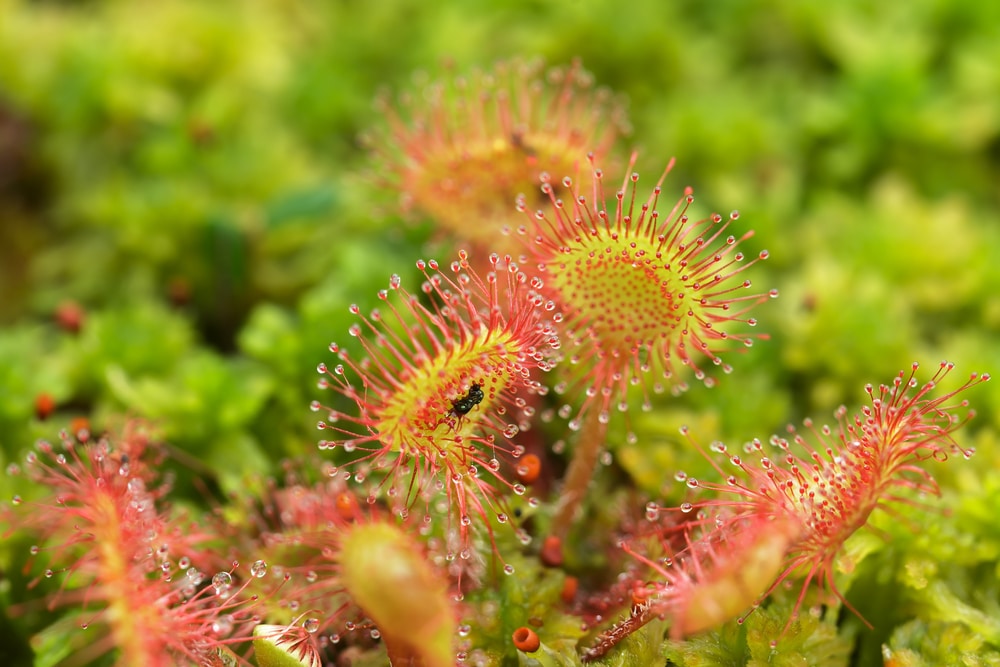
As cool as bigger carnivorous plants may be, there’s something so intriguing about a carnivorous plant as small and inconspicuous as a sundew. These little meat-eaters are a series of stems that form a rosette in the center and splay out to showcase their sticky traps.
Said sticky sundew traps are actually tiny little leaves that curl inward when touched. They’re covered in a forest of little hairs, each with their own drop of sticky, sweet nectar for luring in their prey. It’s easy to look at one under a magnifying glass all day.
When an insect lands on the end of one of these sticky leaf traps, the leaf curls over itself, enclosing the bug inside. It can then form a makeshift capsule out of the many tiny hairs and nectar, then proceed to digest the catch using the same digestive enzymes as other species.
Fortunately, there are literally tons of different kinds of sundew plants, and they’re especially good for growing indoors where fruit flies, soil gnats, or even smaller house flies tend to congregate. Here are a few of the best sundews to try growing indoors.
Big Pink
While its name may not be creative considering the pink coloration and abnormally large size of this sundew, big pink is a fun sundew for those with lots of natural light. The more sunlight this plant gets, the more pink its foliage becomes.
This sundew also doesn’t like to dry out at all. Since it receives lots of sunlight, it also needs lots of water. Big pink is a comparatively thirsty cultivar compared to others, and can’t be allowed to dry out.
A nice plus in addition to the showy foliage of this plant is that it’s also fairly easy to find and relatively inexpensive. A fun sundew like this makes for the perfect trial into growing sundews at home, since they’re also very easy-going with proper care.
Round-Leaved Sundew
Round-leaved sundews are a little bit easier to please, on top of being lots smaller than a cultivar like big pink. However, Drosera rotundifolia is one of the best sundews to grow in a terrarium since it’s not a big fan of direct light or dry air.
These little guys are well worth the trouble of being so helplessly small, one of the perks being that the round-leaved sundew can flower for months on end just before giving you a massive quantity of seeds that you can plant for even more sundews!
The best part about the round-leaved sundew is its coin-shaped sticky traps that sit at the end of each stem, covered in tiny little red drops to lure in very small insects such as fruit flies and mosquitoes!
Cape Sundew
Hands down, the cape sundew is the absolute best choice for first-time carnivorous plant growers. Their dainty appearance is just a small part of what makes them so much fun to have. Though their foliage looks like a smaller version of other cultivars, it’s all in the flowers.
Each flower stem can produce a dozen or more blooms, which are incredibly small but brightly colored pink for an interesting contrast. Don’t forget that the flowers also produce seeds, which if left alone, will carpet the surrounding moss and grow tons of baby cape sundews!
While it prefers humidity and warm temperatures, cape sundews also need to cut back on these things for about six months every year during their dormant season. During this time, the plant may look a little less than healthy, but it’s normal not to see any new growth for a while.
Butterwort
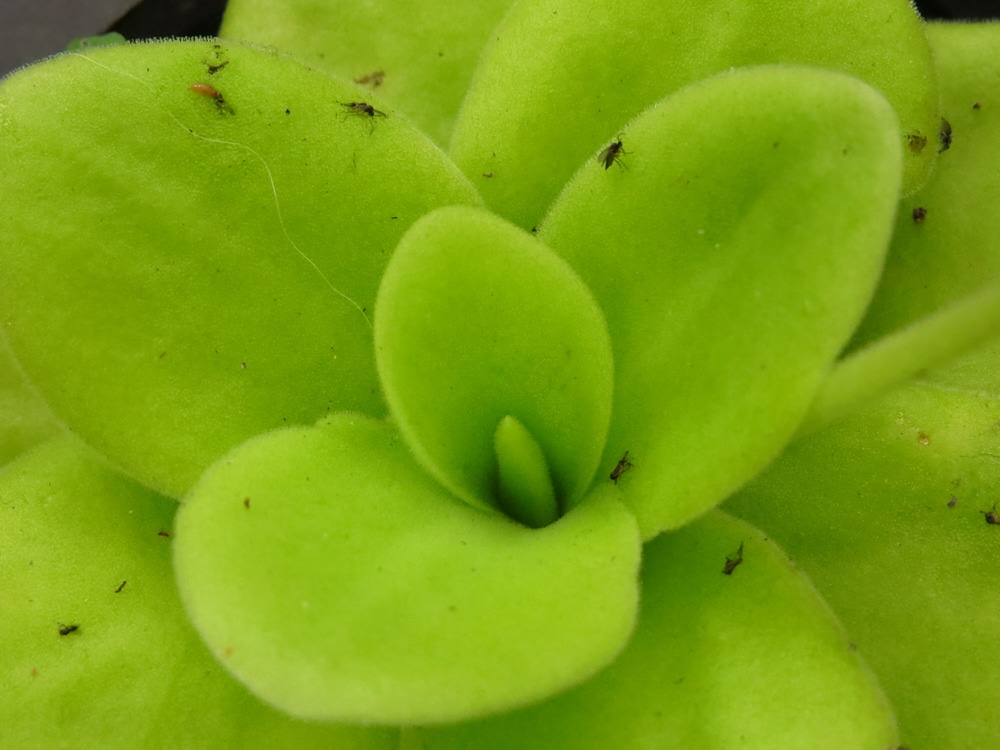
There’s nothing quite like the innocent appearance of a butterwort, perhaps aside from its name. But don’t be fooled; these carnivorous plants are definitely insect eaters. Their prey consists primarily of very tiny bugs such as gnats, flies, and aphids.
The leaves of butterworts are wide, flat, and insanely sticky. However, unlike sundews, butterworts don’t generally physically trap their prey. Instead, they glue them down to the leaf surface with one gland and produce digestive enzymes with another.
The very tiny insects are able to slip through very small pore-like glands in the leaf’s surface, where they will be eventually ingested by the butterwort. This plant also flowers, and those flowers are a bit bigger than those of other carnivores as an added bonus.
The charm of these tiny little plants is immeasurable. Most butterwort species are only about two inches wide, but some can get as large as twelve inches across. They’re a perfect addition to a terrarium in smaller sizes. Here are some of the most noteworthy Pinguiculas.
Red Leaf
This is an all-around fun type of butterwort to grow at home in terrariums or on their own, given proper humidity and light. The allure of this cultivar is its bright red colored leaves, which are particularly attractive to a small set of tiny insects.
The flowers on this plant are also rather impressive in color. Rather than the usual solid pink or purple, the red leaf butterwort has flowers that are creamy white in the center, surrounded by a ring of lilac-colored petal tips.
Having this red coloration makes the red leaves even more sensitive to light than most butterwort species, so it’s important to keep the light in the moderate zone at best to avoid burning or stressing the leaves.
Colimensis
One of the larger Mexican varieties of butterwort, Pinguicula colimensis produces some of the largest leaves of the genus. They’re typically a very pale light green, as most butterworts are, and they produce a very profound rosette during their dormant period.
The flowers on this butterwort are striking. They’re fairly large compared to the size of the plant itself, and usually come in as a brilliant fuschia shade that contrasts sharply with the light green of the foliage and petioles.
There are a few care differences between seasons with this plant, particularly between the seasons when there are carnivorous leaves and the season when the leaves form a succulent rosette. During the succulent phase, Pinguicula colimensis doesn’t eat any insects.
Gigantea
The largest species of butterwort is named as such. Pinguicula gigantea explains it all; this butterwort can grow up to twelve inches in diameter under the right conditions. Unlike most butterworts, though, this species catches insects on both sides of each leaf!
The evolutionary advantage to this unusual arrangement is fairly obvious: more sticky surface space, more opportunity to catch insects. This is a clever tactic for plants that grow in clusters alongside other plants in the wild.
The flowers of the gigantea butterwort can be anywhere from a light violet color to white, depending on their origin region. They prefer bright, indirect light, but will tolerate a small amount of direct light if they have to!
How to Water Carnivorous Plants
Carnivorous plants are common in regions of tropical rainforest, where the natural rainwater that falls is all but filtered clean by the time it reaches the forest floor where many of these carnivorous species dwell.
Others that live in more arid regions, including growing on rocks and alongside succulent plants, still receive fairly clean water, as there’s not much debris or nutrients for the rainwater to pick up on its way to the roots.
For these reasons, it’s important to provide your carnivorous plants with exactly the same kind of water. While most of us can’t hop on a plane to gather fresh tropical rainforest water, we can get close enough with pure, distilled water from the grocery store shelves.
It has been said that reverse osmosis water could be a replacement for distilled water, but unfortunately that’s just not the case. In a pinch, it can be used once or twice for watering, but there are still many impurities that can slip their way through the entire process.
Most carnivorous plants prefer to be watered from the bottom, whilst planted in pots that allow for water to freely move in and out of the bottom of the pot via drainage holes. Some folks even use terra cotta to allow water to wick up to the plant, with proper environmental humidity.
The best way to provide carnivorous plants with the right amount of water is to set them in a tray, from which the plants can soak up the amount of water they need without having to strain for it or drown in it.
Carnivorous plants in general cannot be allowed to fully dry. There’s a saying in the carnivorous plant industry, “if it dries, it dies”, that perfectly sums up how carnivorous plants like their water. However, the soil shouldn’t be constantly soggy to the touch.
New water should be added to a tray below each potted carnivorous plant once the water in the tray has all been used up. Plants should be watered again the same day that all the water from the tray is gone to avoid letting the soil dry out completely.

